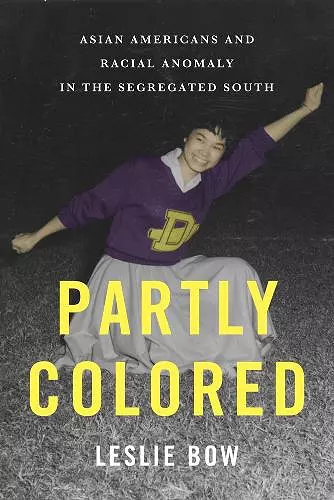Partly Colored
Asian Americans and Racial Anomaly in the Segregated South
Format:Hardback
Publisher:New York University Press
Published:23rd Apr '10
Currently unavailable, and unfortunately no date known when it will be back
This hardback is available in another edition too:
- Paperback£24.99(9780814791332)

Explores the ways in which Asian-Americans came to be understood within Jim Crow's racial logic.
Analyzing pre and post-1954 American literature, film, autobiography, government documents, ethnography, photographs, and popular culture, this title investigates the ways in which racially 'in-between' people and communities were brought to heel within the South's prevailing cultural logic.
2012 Honorable mention for the Book Award in Cultural Studies from the Association for Asian American Studies
Arkansas, 1943. The Deep South during the heart of Jim Crow-era segregation. A Japanese-American person boards a bus, and immediately is faced with a dilemma. Not white. Not black. Where to sit?
By elucidating the experience of interstitial ethnic groups such as Mexican, Asian, and Native Americans—groups that are held to be neither black nor white—Leslie Bow explores how the color line accommodated—or refused to accommodate—“other” ethnicities within a binary racial system. Analyzing pre- and post-1954 American literature, film, autobiography, government documents, ethnography, photographs, and popular culture, Bow investigates the ways in which racially “in-between” people and communities were brought to heel within the South’s prevailing cultural logic, while locating the interstitial as a site of cultural anxiety and negotiation.
Spanning the pre- to the post- segregation eras, Partly Colored traces the compelling history of “third race” individuals in the U.S. South, and in the process forces us to contend with the multiracial panorama that constitutes American culture and history.
Partly Coloredis a work that should be read not only by those interested in the South or regionalism but by all scholars interested in issues of racialization. -- Jennifer Ho * Journal of Asian American Studies *
Bow's work is an imoprtant contribution to Asian American studies and southern literary criticism, and it brings together two forms of intellectual inquiry that have been treated as quite distinct by other scholars. -- Krystyn R. Moon * The Journal of Southern History *
Intelligent and provocative. Partly Colored exemplifies the full possibility of & trans scholarshiptransnational, transracial, transgender, and transdisciplinary. With a deep appreciation of the ways in which mobility, hybridity and interstitiality itself exist within systems of power, accommodating themselves to the tropes and laws of the white supremacist South, Bow consistently demonstrates the telling power of black/white divisions. -- David Roediger,author of How Race Survived U.S. History
Through her brilliantly executed and wide ranging analyses of how Asian Americans, Native Americans and other & partly colored subjects in the American South have been depicted and have depicted themselves, Bow reveals the region to be haunted by a different set of racial histories than the ones with which we have become familiar. She offers a revelatory perspective on how those who occupy the liminal zone between black and white negotiate the dynamic and contradictory social processes that sustain a monochromatic conception of race. -- Daniel Y. Kim,author of Writing Manhood in Black and Yellow: Ralph Ellison, Frank Chin and the Literary Politics of Identity
An impressive and well-researched interdisciplinary response. * MELUS *
Scrutinizing the bipolar axis of power separating black from white under the Jim Crowe system of segregation, Bow tracks the oppression and elision of those who are partly colored"here chiefly Asian Americans but with comparative nods to Native Americans and the binaries characterizing gender and sexuality . . . What she finds is not a "third space" apart from black or white but an eneven extension of repression of racial differences into which Asian American subjects are shoehorned or erased. * Journal of American History *
In a refreshingly wide-ranging study, Bow compares the circumstances of the Lumbee Indians with those of Asiansthe two groups were not classified as black or white. The author considers the consequences of intermarriage in the racialization of Asians, as well as the roles of class and gender. Above all, she explores the rich interstitial possibilities of Asians being in-between set categories. This stimulating read is suitable for a broad audience. * Choice *
ISBN: 9780814791325
Dimensions: unknown
Weight: unknown
296 pages